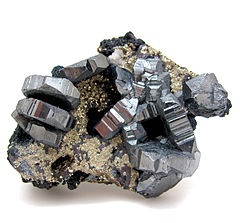Endellionite
| Bournonite | |
|---|---|

Bournonite from Viboras mine, Machacamarcha, Bolivia, 95 mm x 74 mm, largest crystal size: 29 mm
|
|
| General | |
| Category | Sulfosalt mineral |
|
Formula (repeating unit) |
PbCuSbS3 |
| Strunz classification | 2.GA.50 |
| Dana classification | 3.4.3.2 |
| Crystal system | Orthorhombic |
| Crystal class | Pyramidal (mm2) (same H-M symbol) |
| Space group | Pn21m |
| Identification | |
| Color | Steel-gray to iron-black |
| Crystal habit | Crystals short prismatic to tabular, typically striated; commonly as subparallel aggregates. Also massive, granular to compact |
| Twinning | On {110}, commonly forming cross or cogwheel aggregates |
| Cleavage | [010] Imperfect |
| Fracture | Subconchoidal to uneven |
| Mohs scale hardness | 2.5 - 3.0 |
| Luster | Brilliant to dull |
| Streak | Steel-gray to iron-black |
| Diaphaneity | Opaque |
| Specific gravity | 5.7 - 5.9 |
| Pleochroism | Very weak |
| References | |
Bournonite is a sulfosalt mineral species, trithioantimoniate of lead and copper with the formula PbCuSbS3.
It was first mentioned by Philip Rashleigh in 1797 as an ore of antimony and was more completely described in 1804 by French crystallographer and mineralogist Jacques Louis, Comte de Bournon (1751–1825), after whom it was named. The name given by Bournon himself (in 1813) was endellione, since used in the form endellionite, after the locality in Cornwall where the mineral was first found.
The crystals are orthorhombic, and are generally tabular in habit owing to the predominance of the basal pinacoid; numerous smooth bright faces are often developed on the edges and corners of the crystals. They are usually twinned, the twin-plane being a face of the prism (m); the angle between the faces of this prism being nearly a right angle (86° 20′), the twinning gives rise to cruciform groups and when it is often repeated the group has the appearance of a cog-wheel, hence the name Rãdelerz (wheel-ore) of the Kapnik miners. The repeated twinning gives rise to twin-lamellae, which may be detected on the fractured surfaces, even of the massive material.
It is a mineral in medium temperature hydrothermal vein deposits. It commonly occurs with galena, tetrahedrite, sphalerite, chalcopyrite, pyrite, stibnite, zinkenite, siderite, quartz, rhodochrosite, dolomite and barite.
...
Wikipedia
